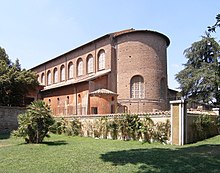Santa Sabina
| Basilica of Saint Sabina at the Aventine Basilica di Santa Sabina all'Aventino (Italian) Basilica Sanctae Sabinae (Latin) |
|
|---|---|
 |
|
| Basic information | |
| Location | Rome, Italy |
| Geographic coordinates | 41°53′04″N 12°28′47″E / 41.88444°N 12.47972°ECoordinates: 41°53′04″N 12°28′47″E / 41.88444°N 12.47972°E |
| Affiliation | Roman Catholic |
| Ecclesiastical or organizational status | Minor basilica |
| Leadership | Jozef Tomko |
| Website | General Curia of the Order of the Preachers |
| Architectural description | |
| Architectural type | Church |
| Groundbreaking | 422 |
| Completed | 432 |
| Specifications | |
| Direction of façade | SW |
| Length | 60 metres (200 ft) |
| Width | 30 metres (98 ft) |
| Width (nave) | 17 metres (56 ft) |
|
|
The Basilica of Saint Sabina (Latin: Basilica Sanctae Sabinae, Italian: Basilica di Santa Sabina all'Aventino) is a historical church on the Aventine Hill in Rome, Italy. It is a titular minor basilica and mother church of the Roman Catholic Order of Preachers, better known as the Dominicans. Santa Sabina is perched high above the Tiber river to the north and the Circus Maximus to the east. It is next to small public park Giardino degli Aranci (Garden of Oranges), which has a scenic terrace overlooking Rome. It is a short distance to the headquarters of the Knights of Malta.
Santa Sabina is the oldest extant Roman basilica in Rome that preserves its original colonnaded rectangular plan and architectural style. Its decorations have been restored to their original restrained design. Other basilicas, such as Santa Maria Maggiore, are often heavily and gaudily decorated. Because of its simplicity, the Santa Sabina represents the crossover from a roofed Roman forum to the churches of Christendom. Its Cardinal Priest is Jozef Tomko. It is the stational church for Ash Wednesday.
Santa Sabina was built by Peter of Illyria, a Dalmatian priest, between 422 and 432 near a temple of Juno on the Aventine Hill in Rome. The church was built on the site of early Imperial houses, one of which is said to be of Sabina, a Roman matron originally from Avezzano in the Abruzzo region of Italy. Sabina was beheaded under the Emperor Vespasian, or perhaps Hadrian, because she had been converted to Christianity by her servant Seraphia, who was stoned to death. She was later declared a Christian Saint.
...
Wikipedia
